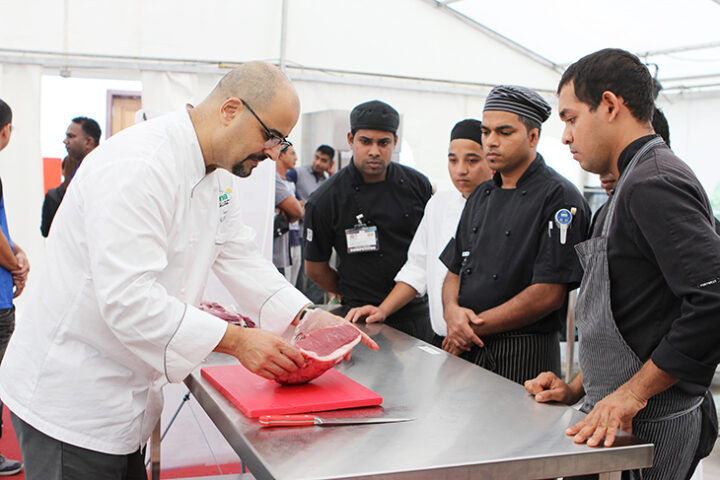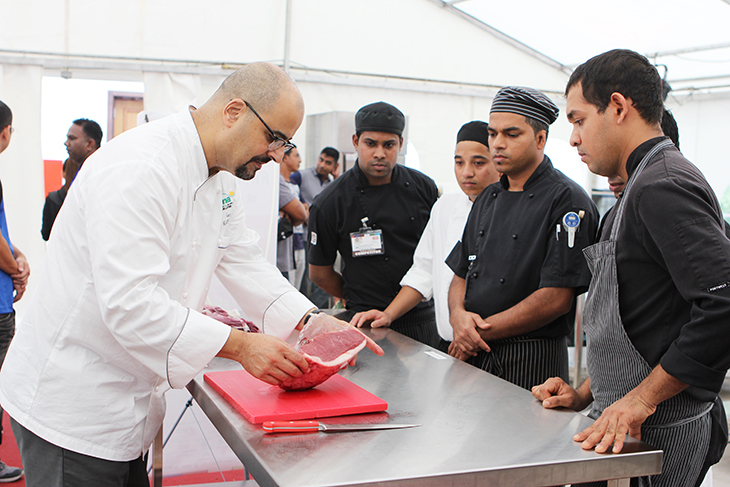
Exclusive: Tarek Ibrahim – interview with a celebrity chef
[vc_row full_width=”” parallax=”” parallax_image=”” bg_type=”” parallax_style=”” bg_image_new=”” layer_image=”” bg_image_repeat=”” bg_image_size=”” bg_cstm_size=”” bg_img_attach=”” parallax_sense=”” bg_image_posiiton=”” animation_direction=”” animation_repeat=”” video_url=”” video_url_2=”” u_video_url=”” video_opts=”” video_poster=”” u_start_time=”” u_stop_time=”” viewport_vdo=”” enable_controls=”” bg_override=”” disable_on_mobile_img_parallax=”” parallax_content=”” parallax_content_sense=”” fadeout_row=”” fadeout_start_effect=”” enable_overlay=”” overlay_color=”” overlay_pattern=”” overlay_pattern_opacity=”” overlay_pattern_size=”” overlay_pattern_attachment=”” multi_color_overlay=”” multi_color_overlay_opacity=”” seperator_enable=”” seperator_type=”” seperator_position=”” seperator_shape_size=”” seperator_svg_height=”” seperator_shape_background=”” seperator_shape_border=”” seperator_shape_border_color=”” seperator_shape_border_width=”” icon_type=”” icon=”” icon_size=”” icon_color=”” icon_style=”” icon_color_bg=”” icon_border_style=”” icon_color_border=”” icon_border_size=”” icon_border_radius=”” icon_border_spacing=”” icon_img=”” img_width=”” ult_hide_row=”” ult_hide_row_large_screen=”” ult_hide_row_desktop=”” ult_hide_row_tablet=”” ult_hide_row_tablet_small=”” ult_hide_row_mobile=”” ult_hide_row_mobile_large=””][vc_column width=”1/1″][vc_column_text]Nashiu Zahir
Tarek Ibrahim hails from Alexandria, Egypt but is based in Dubai. He is a gifted master of his craft, the first chef from the Arab world to attain Masterchef status, certified by World Association of Chefs’ Societies (WACS). He is also a celebrity whose cooking show garners an audience of 350 million people. Hotelier Maldives sits down with the chef to have a tête-à-tête, to find out more about the man himself, his experiences and where he is headed. What’s more, Hotelier Maldives also attended Chef Tarek’s Meat Cuts workshop to learn more than a thing or two about meat.[/vc_column_text][vc_empty_space height=”10″][vc_separator color=”grey” align=”align_center” style=”” border_width=”” el_width=””][vc_empty_space height=”10″][vc_single_image image=”8430″ border_color=”grey” img_link_large=”” img_link_target=”_self” img_size=”full”][vc_empty_space height=”10″][vc_column_text]Could you tell us a bit about where you grew up, your childhood experiences, whether you were into cooking even then?
I grew up in a house where I lived with five women; my mother, my two sisters and two aunts. The house we lived in was in the seaside city of Alexandria. My favourite spot in the world. At that time food in my home was literally made from scratch. Even the breads! The meats, desserts, everything was made at home and that’s the kind of environment I grew up in. Cooking from scratch is a wonderful experience, it gave me the chance to see something beautiful and delicious being created.
And I sometimes cooked stuff on the beach. We lived so close to the sea, I’d cook fish, sea urchins, octopus, but only my mother cooked at home. So yes, I did have an interest even back then.
What was school like for you? Did you get into culinary school?
After I finished high school I wanted to attend culinary school. But my father wasn’t happy at all. I also wanted to fly but my father didn’t want me risking my life. I wanted to be a musician as well, but that wasn’t to his taste either! He wanted me to be an engineer. I ended up going to a surveying and mapping school and got to fly a bit during aerial mapping.
When I was done with school I told my father that it was time for me to do something that I wanted. So I went travelling, and in Greece, I met the woman who would become my wife. Then we went to America, around ‘86 where I went to aviation school – I had a love for flying as I mentioned. But after I had finished school, I found out that I had a medical condition that prevented me from flying professionally.
How did your culinary journey begin?
Well it started because I had to find some work. I was playing music but that wasn’t making me a lot of money. Soon I found a job at a coffee shop/bakery called Upper Crust, in Minnesota. I learnt how to cook, and I worked behind the counter so I learnt the English language. I was saving a lot of money because I ate at the coffee shop so I didn’t have much in the way of bills – just utilities and rent. I was also working at the Hyatt. And soon I became manager of Upper Crust. And with the money I’d saved I was able to buy the place in three years, after paying a down payment.
I really taught myself how to cook there, and I loved it. Making bread, or pastry, or meat, I didn’t do any of it in big quantities so I had the opportunity to really focus on the quality. Everything had to be perfect. Also I was working on a small budget so I could not afford to mess anything up.
What was a defining moment in your career?
Well, once when I was sitting at the restaurant, the chef from the American Culinary Federation walked in and tried some of the food. He was full of praise and asked me to join their organisation, to do bigger things. And so I joined them; it’s a body to help chefs. It was an eye-opening experience for me because I started getting exposed to a lot of chefs, to different ways of thinking. That was really where I dipped my toe into the professional chefs’ arena. After that, I bought and sold restaurants. I taught in a culinary arts school in Minnesota, and the experience really enhanced my knowledge.
Another defining moment was when I met a Chicago chef, Charlie Trotter, who taught me how to train my taste-buds by blocking out the sense of sight and smell and trying to recognise flavours. It was really something incredible, I’d fail completely in the beginning but later on I began to recognise stuff.
You must get asked this a lot but what inspires you?
In a word, simplicity. I like to give people high quality, tasty food that does not require a tremendous effort to prepare. I want to give people something simple, tasty and elegant. I find housewives, my mother for instance, very inspiring in this way.
What plans do you have for the future?
I’d like to retire, settle back in Egypt. I want to start a very small cooking school for the elite and the underprivileged, with the elite funding the education of the less privileged. It might be an interesting thing. I’m a strong believer in the idea that the rich have a responsibility towards the less privileged, in making their lives better.[/vc_column_text][vc_empty_space height=”10″][vc_separator color=”grey” align=”align_center”][vc_empty_space height=”10″][vc_column_text]
Dispelling meaty misconceptions
Masterchef Tarek Ibrahim holds meat cuts workshop at Hotel Asia 2015
So you think you know your beef? Well, think again. Masterchef Tarek Ibrahim conducts a special seminar to dispel myths and inform those interested enough to learn a thing or two on the subject.
Ibrahim, who represents Meat and Livestock Australia, begins with an exhortation. “I urge everyone to read,” he says. “I’m not where I am because I’m smart, but because I read a lot.”
He asks the audience whether beef was all the same. Everybody answers in the negative.
“When we talk about beef, we have to really understand a few things,” Ibrahim says. “Breed, feed regime, age of the animal, ageing of the carcass, temperament, the cuts, the cooking methods, condiments and other flavour inputs.”
Then he begins explaining these components in detail.
There are two general breeds of cows; European and tropical. European breeds like Angus and Limousin are well known, with the former being bred in places like Australia. Popular tropical breeds include the Brahman, a species originally from India but which is popular in Texas and in Brazil.
A vastly popular breed is undoubtedly Wagyu, which literally translates to “Japanese cow”. What is special about Wagyu is that it has natural marbleisation; pockets of fat contained between fibres of the meat. “These start to explode when you bite into the meat,” says Ibrahim. “And they give you this gorgeous flavour.”
The meat of a young calf is very pale because it drinks only milk. As it ages and starts eating grass and grain, the meat becomes richer, darker. Is there a way to tell if a particular cow has been fed grain or grass? Interestingly enough, there is! The cap of fat of grass-fed animals is yellowish, because of carotene in the grass. If the cap of fat is whitish, it is indicative of the animal being grain-fed. Also grass-fed cows’ flesh is very ‘meaty’ and pungent whereas the taste of a grain-fed cow is ‘smoother’. What’s more, as an animal ages its meat becomes tougher; the more they move about the tougher the muscles get.
Ageing tenderises the meat and there are two ways that you can do this; dry and wet ageing. In dry ageing the carcass is hung to dry for several weeks in near-freezing temperatures. This method of ageing is expensive and Ibrahim believes it does not add significantly to the taste. Wet ageing, whereby the beef is aged in a vacuum sealed bag, is less costly and time consuming. “Only a very remarkable connoisseur of meat can taste the difference between the two,” says Ibrahim.
How you treat your animal matters. Good temperament affects the quality of the meat. If the cow is scared, it produces adrenaline which increases the acidity of its flesh. “Both quality and shelf life will plummet, so it’s really important to take good care of your cows.”
There is a rule of thumb when it comes to meat cuts. Striploin, cube roll and tenderloin are very versatile. And contrary to popular opinion, tougher parts of the animal, like the knuckle can yield flavourful steaks. Tough does not necessarily mean bad. Chuck and brisket are fantastic for mincing. Only 1.8 percent of the carcass is tenderloin, which is why it is expensive. But it is not the most flavourful cut and needs to be accompanied with a condiment. Conversely, cube rolls and strip-loin can be cooked and had with just salt and pepper. If you are cooking rump, do not get rid of all the fat. In fact, cook the meat in the fat so that it absorbs the flavour. All cuts of beef when cooked right can deliver fantastic results. As Ibrahim says it is not the cut, but the chef.
“Don’t ever be a chef that just seeks a recipe,” says Ibrahim, concluding the seminar. “Read, investigate and experiment, and find out what works for you.”[/vc_column_text][/vc_column][/vc_row]







